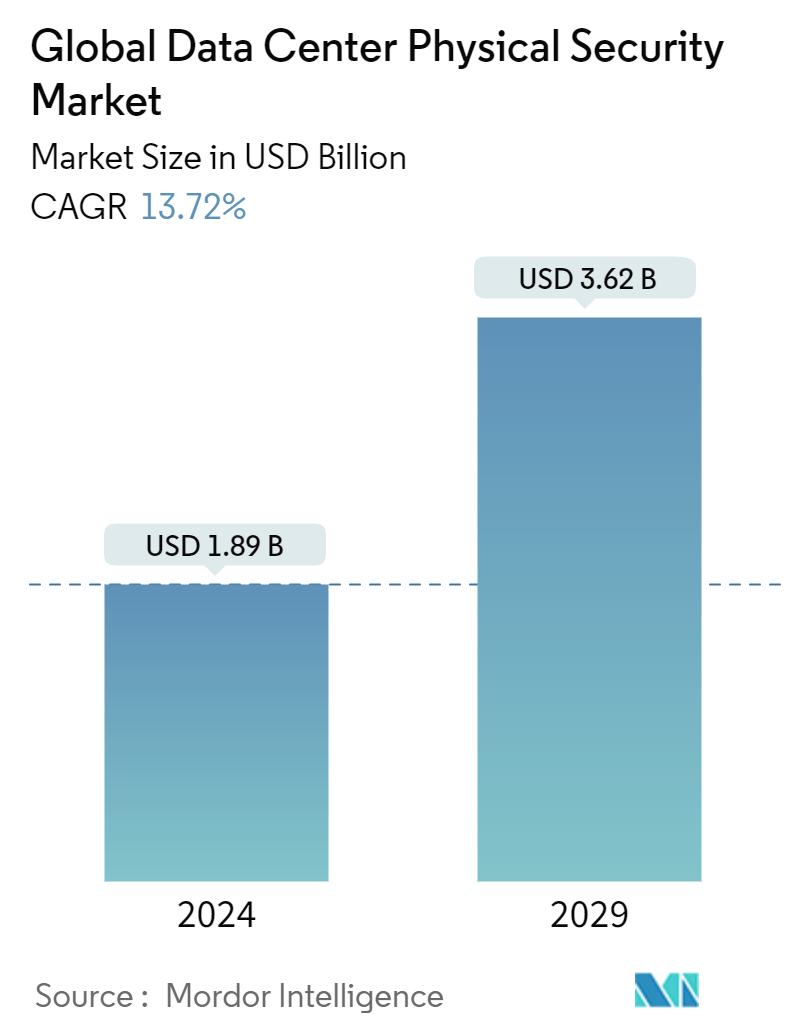Market Size of Global Data Center Physical Security Industry

| Study Period | 2018 - 2029 |
| Market Size (2024) | USD 1.89 Billion |
| Market Size (2029) | USD 3.62 Billion |
| CAGR (2024 - 2029) | 13.72 % |
| Fastest Growing Market | Asia Pacific |
| Largest Market | North America |
Major Players
*Disclaimer: Major Players sorted in no particular order |
Global Data Center Physical Security Market Analysis
The Global Data Center Physical Security Market size is estimated at USD 1.89 billion in 2024, and is expected to reach USD 3.62 billion by 2029, growing at a CAGR of 13.72% during the forecast period (2024-2029).
Security measures can be categorized into four, namely perimeter security, computer room controls, facility controls, and cabinet controls. The first layer of data center security discourages, detects, and delays any unauthorized entry of personnel at the perimeter. In case of any infringement in the perimeter monitoring, the second layer of defense denies access. It is an access control system utilizing card swipes or biometrics.
The third layer of physical security further restricts access through various verification methods, including monitoring all restricted areas, deploying entry restrictions such as turnstiles, providing biometric access control devices to verify finger and thumbprints, irises, or vascular patterns, providing VCA, and using radio frequency identification. The first three layers ensure the entry of only authorized people. Further security to restrict admission includes cabinet locking mechanisms. This layer addresses the fear of an 'insider threat,' such as a malicious employee.
The upcoming IT load capacity of the global data center physical security market is expected to reach 71,000 MW by 2029.
The construction of raised floor area in the market studied is expected to increase to 273.9 million sq. ft by 2029.
The region's total number of racks to be installed is expected to reach 14.2 million units by 2029. North America is expected to house the maximum number of racks by 2029.
There are close to 500 submarine cable systems connecting the regions globally, and many are under construction. One such submarine cable that is estimated to start service in 2025 is CAP-1, which stretches over 12,000 km with a landing point in Grover Beach, United States.
Global Data Center Physical Security Industry Segmentation
The data center physical security market refers to the industry focused on providing products and services to safeguard the physical infrastructure and assets of data centers. This includes measures to protect data centers from unauthorized access to premises, hardware theft, vandalism, sabotage, terrorist acts, and other physical threats. The key components of data center physical security include video surveillance and monitoring, access control systems, physical barriers, biometric authentication, and environmental controls designed to ensure the safety and integrity of the data center environment.
The global data center physical security market is segmented by solution type (video surveillance and access control solutions), service type (consulting services and professional services), end user (IT and telecommunication, BFSI, government, healthcare, and other end users), and geography (North America, Europe, Asia, South America, Middle East, and Africa). The market sizes and forecasts are provided in terms of value (USD) for all the above segments.
| By Solution Type | |
| Video Surveillance | |
| Access Control Solutions | |
| Others (Mantraps, Fences, and Monitoring Solutions) |
| By Service Type | |
| Consulting Services | |
| Professional Services | |
| Others (System Integration Services) |
| End User | |
| IT and Telecommunication | |
| BFSI | |
| Government | |
| Healthcare | |
| Other End Users |
| Geography | |
| North America | |
| Europe | |
| Asia | |
| South America | |
| Middle East | |
| Africa |
Global Data Center Physical Security Market Size Summary
The global data center physical security market is poised for significant growth, driven by the increasing need for robust security measures to protect sensitive data and infrastructure. This market encompasses various security layers, including perimeter security, access control systems, and advanced verification methods such as biometrics and radio frequency identification. The rising interconnectedness of devices and the growing accessibility of biometric equipment are key factors propelling market expansion. As security breaches become more frequent and costly, the demand for effective access control solutions is expected to rise, with companies like LenelS2 and Bosch leading the charge in providing innovative security technologies.
North America, particularly the United States, is a leading region in adopting physical security solutions, supported by stringent data protection regulations like the California Privacy Rights Act and the Personal Information Protection and Electronic Documents Act in Canada. These regulations drive the demand for compliant security solutions. The market is characterized by a high level of competition, with major players such as Axis Communications AB, ABB Ltd, and Bosch Sicherheitssysteme GmbH focusing on expanding their market share through strategic collaborations and innovative product offerings. Recent developments, such as Bosch's Mobile Access solution and Schneider Electric's EcoCare services, highlight the ongoing efforts to enhance data center security and efficiency.
Global Data Center Physical Security Market Size - Table of Contents
-
1. Market Dynamics
-
1.1 Market Overview
-
1.2 Market Drivers
-
1.2.1 Increased Data Center Activities and Investment by the Hyperscale and Colocation Operators
-
1.2.2 Advancements in Video Surveillance Systems Connected to Cloud Systems
-
-
1.3 Market Restraints
-
1.3.1 Operational and Return On Investment Concerns
-
-
1.4 Value Chain / Supply Chain Analysis
-
1.5 Industry Attractiveness - Porter's Five Forces Analysis
-
1.5.1 Threat of New Entrants
-
1.5.2 Bargaining Power of Buyers/Consumers
-
1.5.3 Bargaining Power of Suppliers
-
1.5.4 Threat of Substitute Products
-
1.5.5 Intensity of Competitive Rivalry
-
-
1.6 Assessment of COVID-19 Impact
-
-
2. MARKET SEGMENTATION
-
2.1 By Solution Type
-
2.1.1 Video Surveillance
-
2.1.2 Access Control Solutions
-
2.1.3 Others (Mantraps, Fences, and Monitoring Solutions)
-
-
2.2 By Service Type
-
2.2.1 Consulting Services
-
2.2.2 Professional Services
-
2.2.3 Others (System Integration Services)
-
-
2.3 End User
-
2.3.1 IT and Telecommunication
-
2.3.2 BFSI
-
2.3.3 Government
-
2.3.4 Healthcare
-
2.3.5 Other End Users
-
-
2.4 Geography
-
2.4.1 North America
-
2.4.2 Europe
-
2.4.3 Asia
-
2.4.4 South America
-
2.4.5 Middle East
-
2.4.6 Africa
-
-
Global Data Center Physical Security Market Size FAQs
How big is the Global Data Center Physical Security Market?
The Global Data Center Physical Security Market size is expected to reach USD 1.89 billion in 2024 and grow at a CAGR of 13.72% to reach USD 3.62 billion by 2029.
What is the current Global Data Center Physical Security Market size?
In 2024, the Global Data Center Physical Security Market size is expected to reach USD 1.89 billion.

